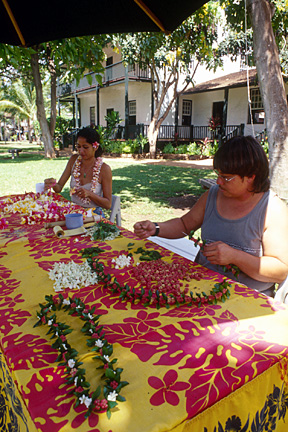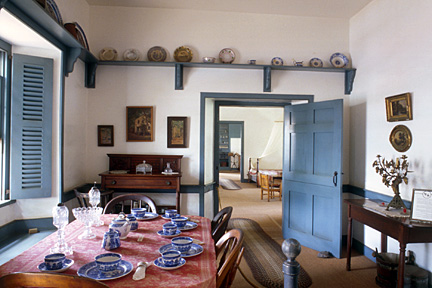
|
Hawaii’s
Back Yard |
Baldwins’ history
preserved with house
Dwight Baldwin needed a bride. The 32-year-old minister from New York had accepted a call to serve in Hawaii, but a month before he was to set sail with the Fourth Company of Protestant missionaries in 1830, he learned the American Board of Commissioners for Foreign Missions would not send him to a foreign land without a wife.
If you go ...What: Baldwin HomeAddress: 120 Dickenson St., Lahaina, Maui Hours: 10 a.m. to 4 p.m. daily Admission: $3 per person, $5 per couple, $2 for seniors aged 55 and older, free for children through the 12th grade. Twenty-minute guided tours of the house ground floor take place continually, as visitors arrive. The second floor houses Lahaina Restoration Foundation offices. Call: (808) 661-3262 E-mail: lrf@hawaii.rr.com Web site: www.lahainarestoration.org Notes: The Lahaina Restoration Foundation is the steward of 30 historical sites in Lahaina. In addition to the Baldwin Home, the most notable of these include the Wo Hing Museum, which formerly served as a temple and social hall for the Chinese fraternal Wo Hing Society; Hale Paahao, the mid-1800s prison; and Hale Pai, literally "house of printing," located on the Lahainaluna High School campus. Check out LRF's Web site for more information about these and other sites.
|
How was he going to be able to meet a young woman willing to commit to such a life, let alone marry her, in such a short time?
Two friends thought 25-year-old Charlotte Fowler would be the ideal mate for him. Well educated and an active Christian who had engaged in missionary work in New Jersey, she had expressed a desire to spread the gospel to worthy souls in foreign countries who had not yet had the opportunity to hear it.
In late November 1830, Baldwin's friends accompanied him to the Fowler residence near New Haven, Conn., to meet Charlotte. An hour after being introduced to her, Baldwin proposed. She accepted a week later, and they immediately exchanged vows in her parents' home.
Three weeks after their wedding, on Dec. 28, 1830, the Baldwins were bound for Hawaii aboard the whaling ship New England.
Their arduous journey took more than five months. Baldwin described one particularly fierce storm in his journal: "(The waves) seemed not only endued with living fury, but to infuse it into the ship. She raged like the waves -- dashed her head into them like a mad bull -- and one threw her off onto another, as though she was a contemptible little thing. The ship made thousands of plunges this day. ... It was hard for our faith to believe she would not go to the bottom."
In contrast, the Baldwins' first post in Hawaii was pretty, peaceful Waimea on the Big Island. The cold, damp climate there, however, took a toll on his health. In 1835, hoping to help him recover, the mission board transferred him and his family to the warm, dry seaport of Lahaina on Maui.

The Baldwin Home draw about 40,000 visitors annually, who may have the opportunity to watch Hawaiian craft demonstrations.
In 1838 they moved into the house built by Rev. Ephraim Spaulding, who had returned to America because of ill health.
Completed in 1835, the modest structure included a sitting room, dining room, master bedroom, a second smaller bedroom and a cellar, where the mission's supplies for Maui were stored.
Its 2-foot-thick walls were made of coral and cut volcanic stone.
The interior was plastered and whitewashed, and the support beams were made of hand-hewn ohia wood. Windows were fitted with 8-by-10-inch glass panes, and the roof was shingled.
Vibrant gardens embraced the house -- rows of pineapples; kou, kukui, cassia, fig, breadfruit, banana, guava and pomegranate trees; vines studded with clusters of large, sweet grapes; and numerous other plantings of fruits, flowers and vegetables.
It was here that for the next 35 years the Baldwins lived, worked and raised their children: Dwight David, Abigail Charlotte, Charles Fowler, Henry Perrine, Emily Sophronia and Harriet Melinda (two other children, Mary Clark and Douglas Hoapili, died before they reached age 3). Throughout their stay in Lahaina, the family welcomed a steady stream of visitors, from Hawaiian chiefs to sea captains to the injured and infirm.
Details about Dwight Baldwin's medical education is sketchy. He graduated from Yale in 1821 and from Auburn Theological Seminary in 1828. Between 1821 and 1830, he apprenticed with a few doctors and studied medicine at Harvard and other institutions (unnamed in his autobiography). In 1863 he received an honorary medical degree from Dartmouth College, and for most of his tenure as a missionary and pastor of Wainee (now Waiola) Church, he was the only American doctor servicing Maui, Molokai and Lanai.
From 1840 to 1846, Baldwin made several additions to his compound, including a study/dispensary and children's bedroom in the main house, and a cookhouse, milk house, small adobe guest house, privy and canoe house nearby.
From late 1847 to mid-1849, the house again was enlarged, this time with a new second story that provided a spacious bedroom for the four younger children, a small storeroom /bedroom and a quiet study for Baldwin (his original office faced bustling Front Street).

The 19th century Baldwin Home in Lahaina was restored in 1966 as a museum housing the family's heirlooms.
After their son Henry purchased the Lahaina homestead in 1887 for $1,900, he and his wife, Emily, ran a library and evening school there for several years. The house became a boarding school for single women in 1922, and during World War II, it served as a USO unit.
In 1964, Henry's estate leased the house to the Lahaina Restoration Foundation, a nonprofit organization that had been founded two years earlier to "restore, maintain and interpret the physical, historical and cultural legacy of Lahaina."
LRF meticulously restored the Baldwin Home in 1966 as a museum accurately portraying 1850s missionary life. Henry's estate donated the property to the foundation the following year.
The oldest house on Maui, it can never be sold and will remain in the public domain in perpetuity.
Today, under the auspices of LRF, the Baldwin Home draws some 40,000 visitors annually. It is furnished with many original period pieces, such as Charlotte's Windsor rocking chair, which came around Cape Horn with her; a sewing chest (she taught the native women and all of her children, including the boys, how to sew); Dwight Baldwin's medical instruments; and the family's delicate Blue Willow china.
Other notable items include an early-1800s octant that was used to plot the course of the moon; a portrait of Dwight Baldwin painted for $15 in 1847 by J.B. Knapp, a whaler in Honolulu; four different views of the Baldwin Home -- one painting, two watercolors and one drawing -- done in the late 1800s; and a four-poster koa bed crafted by the Rev. William P. Alexander in 1850.
Docents like to point out the wooden crib, which dates back to the mid-1800s. Says Jay Kolona, LRF's administrative assistant: "You know how you can now buy those expensive cribs that can convert to a single bed as the child grows older?
"Well, that's exactly what this crib does, so that's not a new idea. The missionaries didn't have much in the way of material possessions, but they were very adaptable and resourceful."

"On the tour of the house, you see things that the Baldwins actually used -- dishes, clothing, books, furniture and more," he says. "From these simple items, you get a real sense of who they were and the challenges they faced as they did God's work among people whose language and culture differed greatly from theirs."
Descendants of Dwight and Charlotte Baldwin span seven generations on Maui. Over the years they have emerged as leaders in every sector of the community, from business and politics to education and the arts.
"And if you think about it," Freeland muses, "the Baldwins' amazing history on Maui began right here, at their beloved home in Lahaina."
E-mail to Travel Desk
[News] [Business] [Features] [Sports] [Editorial] [Do It Electric!]
[Classified Ads] [Search] [Subscribe] [Info] [Letter to Editor]
[Feedback]
